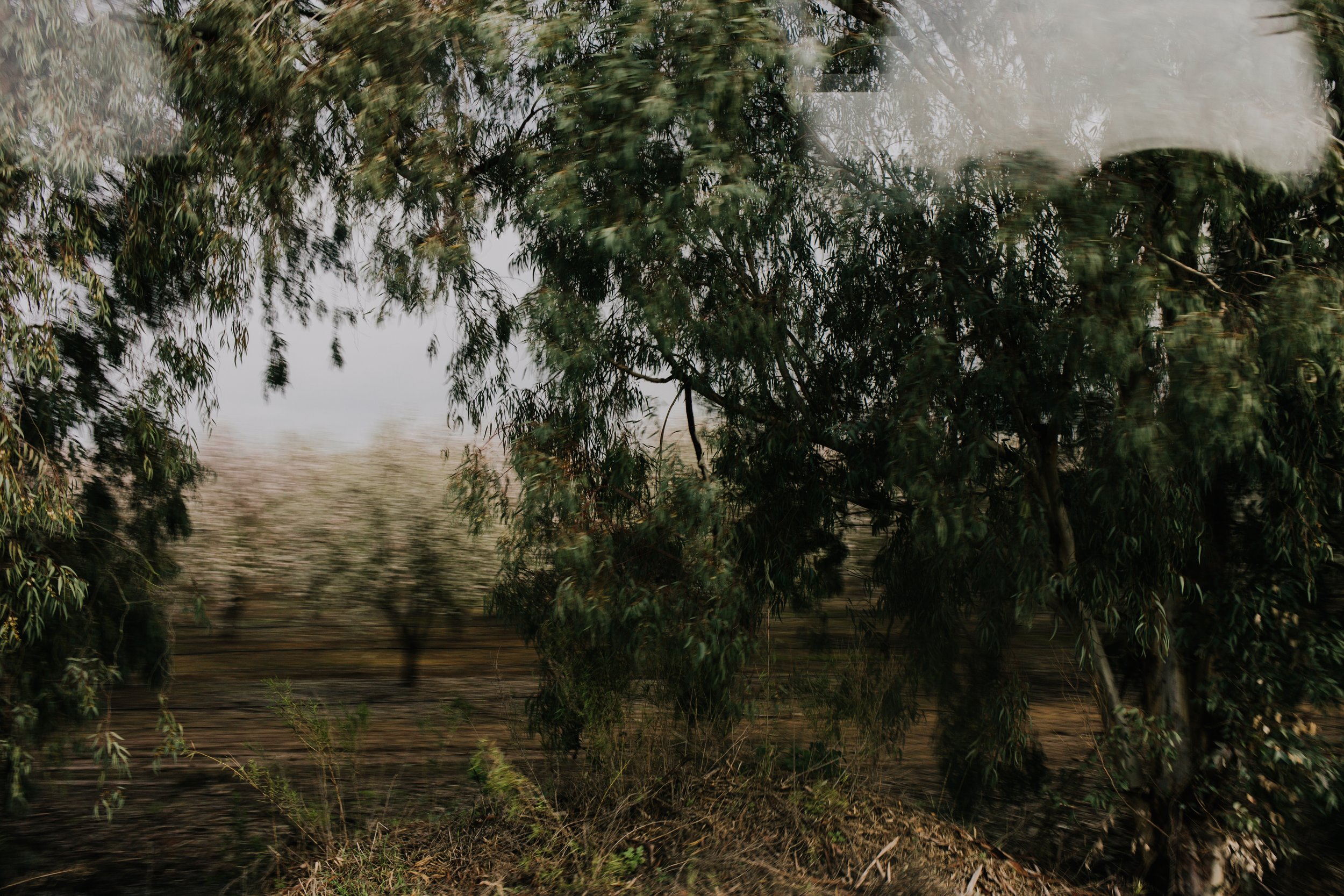A Somebody with a Body

A Somebody with a Body
Sarah Finley Purdy
On Flannery O’Connor, Andy Warhol & the Incarnation
THE BIRTH
It starts with the earliest and smallest changes in the body, feeling them hint at progression. Like a wheel turning, the body gains speed. Panic and joy and excitement and terror intermingle; nausea mixes with fatigue, tears and overwhelming joys. A future tumbles out of the heart and the mouth—plans must be made.
Then, the grinding halt. Waking up on a Sunday morning to feel no symptoms, just an eerie pain in the stomach as hymns fall out of mumbling mouths and into the empty pews. The body can function strangely, quietly, without permission from our cognitive selves. How like death to creep in silently and take grip before one has a chance to fight it off.
The body can function as an intuitive gauge to our emotional and spiritual life, communicating our sadness, trauma, joy, and stress—but in languages we do not always recognize. We must be trained and learn how to hear our bodies speaking.
This side of heaven, bodies are beautifully fragile and limited realities, yearning for fullness. It’s easy to overromanticize them—to focus solely on their joy and pleasure, or, conversely, to reject all forms of materialism and act as if all that matters to God is our chaste spiritual selves.
I gave little thought to my physical body as a child, outside of my hair which had to be tied back as it grew long, done up in fun barrettes and headbands; or my clothes, which I adored dressing up in, for play and special occasions. Puberty changed all of that. And as a homeschooler dropped suddenly into a public school system, the awareness surrounding my body came sharp and quick. My stomach never seemed flat enough, my hair never straight enough, my hips wider than other girls my age. A friend pointed out one day that my smile was crooked—a criticism that sent me into a long despair, thinking for years that I was truly an odd and ugly girl.
*
THE INCARNATION
In the midst of my pandemic isolation, I found a woman whose writing mirrored many of my own bodily concerns. I sat at home, battling the sickness and diving deep into the fiction of Flannery O’Connor. O’Connor’s work is characterized by individuals who are devastatingly limited by their physical bodies, as well as those who are sometimes able to transcend them through God’s mysterious grace—even in the midst of cruel violence or severe trial. Her characters’ lives are defined by realistic spiritual and physical limitations of body, and time, and place.
O’Connor expressed her enthusiastic awe when writing about Christ’s bodily humanity. In a 1955 letter to Betty Hester, a Southern writer and regular literary correspondent, O’Connor emphasized the physical incarnation of Christ. In one of her most noted letters to Hester she wrote, “To see Christ as God and man is probably no more difficult today than it has always been, even if today there seem to be more reasons to doubt. For you it may be a matter of not being able to accept what you call a suspension of the laws of the flesh and the physical, but for my part I think that when I know what the laws of the flesh and the physical really are, then I will know what God is. We know them as we see them, not as God sees them. For me it is the virgin birth, the Incarnation, the resurrection which are the true laws of the flesh and the physical. Death, decay, destruction are the suspension of these laws.”
O’Connor understood the limited physical self at an exceptionally intimate level. In her letters to friends she wrote of the adjustments to her assistive devices and how they impacted where she sat and read, or how differently she contemplated the act of moving around the room during the day. After losing her father to lupus, she herself was diagnosed with the disease at the age of 25. As the sickness spread, she relied on assistive walking devices before her death at the age of 39.
Haydin Olivia Oechsle
In the haze of O’Connor’s work, I stand under a bright bathroom light. It’s Sunday morning and I’m almost ready for church when I notice my arms: pale and winter-dry. Right where the short sleeves of my sweater give way to my bicep, I notice little crosshatching lines that strike me in its familiarity to the skin of my mother, and even my grandmother. I came from those bodies and now I carry small likenesses, not just in my asymmetrical smile or maternal mannerisms, but in patches of skin covering bone.
What a wonder it is that Christ took on the job of “infleshing,” as my pastor likes to describe it, to look like us—took on our bodily form, so as to appear like a relative. We are not only adopted into his family, but he came down to us in a way that would be indicative of physical family ties. He was not Spirit alone but flesh and blood, a human man! With all the joys and sadness that came with being embodied in this world.
*
THE RESURRECTION
The intertwined realities of our body and spirit are undeniable, especially in this fraught era. Traversing back into the world after two years of pandemic regulations has had a surprising effect on how I perceive my own body. Returning once again to the physical community of church and city crowds, I feel painfully aware of my own embodied existence in relation to others—the size of my stature, the space I take up, readjusting with each new person I interact with. In early April I took a trip to New York City after almost three years to visit friends over a long weekend. Being in a different climate and more stimulated than I’d been since prepandemic days, I found myself dehydrated, exhausted, and sleepless after just 48 hours outside of my normal routine. The most humanizing experiences can be the ones where we realize our own fragility.
While in New York, I visited the Brooklyn Museum to see the traveling exhibition Andy Warhol: Revelation. In 2019, The Andy Warhol Museum compiled this collection of Warhol’s work, exploring the influence of the artist’s Byzantine Catholic faith on his work. The traveling show surprised many critics and visitors who were unaware of Warhol’s religious affiliations.
The son of Slovakian immigrants who migrated to Pittsburg, Pennsylvania, Warhol regularly attended mass with his mother while growing up, and actively collected iconography and ephemera related to the Catholic church for the majority of his life. A queer man, Warhol tried to maintain distance and privacy between his personal life and spiritual upbringing, but his use of iconography of the church is pervasive and important to understanding the full body of his work.
In 1968, Warhol was shot by radical writer Valerie Solanas and severely injured. The incident left his body covered in large scars, and he required the assistance of medical corsets for the remainder of his life. Warhol’s recovery after this harrowing incident has been deemed by some as a “resurrection,” as doctors attending to him after the gunshot thought they had lost him completely for a brief period. With Warhol’s bodily scars famously documented by photographer Richard Avedon, the physical body and the spiritually sacred became increasingly prominent themes within his artwork. His utilization of repetitive imagery dovetailed harmoniously with the repetitive nature of religious iconography and daily acts of veneration.
Visiting the exhibition this spring, I found myself curiously engaged by Warhol’s piece The Last Supper (Be a Somebody with a Body), which overlays one of Warhol’s striking, muscular men with an image of Christ. The Andy Warhol: Revelation exhibition catalog notes the divine parallel between Catholicism and the importance that physical bodies play to the iconography and theology of the church. Whether it was the artist’s intention or not, I can’t help but to view his piece as an affirmation of our status as beings made in the image of God. We exist physically in a form that is both touched by our fleshly desires, even our fragility, yet hinges on the beauty of God’s likeness in us. The two images can never really be divorced—Christ’s outline in the painting hovering, translucent, like the Spirit over the man.
*
Being in a body is wholly tiresome business. My own struggle with several invisible, chronic health conditions leaves me fatigued and battling painful symptoms on a weekly basis. I’ve quickly found that conception is not always a given, even for someone considered relatively “healthy” or of childbearing age. Inhabiting a body is at times hard, disappointing, devastating work.
In contrast to my own physical experiences, I’ve been marveling at the fact that Christ’s body was without limits. He had the power to heal any person of any illness or ailment, to reattach severed body parts, to defy the laws of nature by walking on water. His humility on the cross was not just a spiritual submission, but one of bodily proportions; by allowing himself to be beaten, stabbed, killed, Christ subverted his godly form and allowed his human body to be broken in a divine act that defied both death and physical limitations.
We are told that from the beginning, the Word became flesh. It was not enough to give us written words or stories or commandments. We needed an infleshing of all the goodness of God. Jesus as fully God and fully man will remain, conceptually, just out of reach of our full comprehension—until one day we are able to see beyond a dimly lit mirror. Until then, we are given our own bodies, God’s image–bearing bodies, to be the hands and feet of the God-man here on earth. To be a somebody with a body is no mere materialism, but the greatest aspect of the laws of the flesh that we have in this brief, beautiful life.
Sarah Finley Purdy
Writer & Fashion Historian
Sara has worked for the Calvin Klein archives, the Costume Institute at the Metropolitan Museum of Art, and FOUNT.
Photography by David Edler





